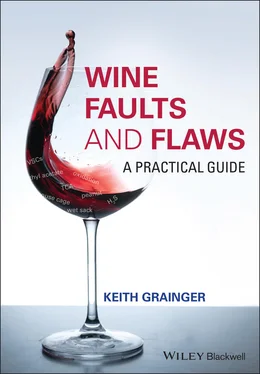Keith Grainger - Wine Faults and Flaws
Здесь есть возможность читать онлайн «Keith Grainger - Wine Faults and Flaws» — ознакомительный отрывок электронной книги совершенно бесплатно, а после прочтения отрывка купить полную версию. В некоторых случаях можно слушать аудио, скачать через торрент в формате fb2 и присутствует краткое содержание. Жанр: unrecognised, на английском языке. Описание произведения, (предисловие) а так же отзывы посетителей доступны на портале библиотеки ЛибКат.
- Название:Wine Faults and Flaws
- Автор:
- Жанр:
- Год:неизвестен
- ISBN:нет данных
- Рейтинг книги:4 / 5. Голосов: 1
-
Избранное:Добавить в избранное
- Отзывы:
-
Ваша оценка:
- 80
- 1
- 2
- 3
- 4
- 5
Wine Faults and Flaws: краткое содержание, описание и аннотация
Предлагаем к чтению аннотацию, описание, краткое содержание или предисловие (зависит от того, что написал сам автор книги «Wine Faults and Flaws»). Если вы не нашли необходимую информацию о книге — напишите в комментариях, мы постараемся отыскать её.
FLAWS
Wine Faults and Flaws: A Practical Guide
An essential guide to the faults and flaws that can affect wine
Wine Faults and Flaws — читать онлайн ознакомительный отрывок
Ниже представлен текст книги, разбитый по страницам. Система сохранения места последней прочитанной страницы, позволяет с удобством читать онлайн бесплатно книгу «Wine Faults and Flaws», без необходимости каждый раз заново искать на чём Вы остановились. Поставьте закладку, и сможете в любой момент перейти на страницу, на которой закончили чтение.
Интервал:
Закладка:
2.7.3 Dryness/Sweetness
Before discussing perceptions of sweetness, it is pertinent to visit the topic of grape sugars briefly. Grapes contain glucose (grape sugar) and fructose (fruit sugar) which will be completely or partially converted by the action of yeasts to ethanol and carbon dioxide during the fermentation process. If there is insufficient natural sugar in grapes to produce a balanced wine with the required alcoholic degree, in some countries the winemaker may add sucrose to the must, a process generally known as must enrichment or chaptalisation. There can be no doubt that the process reduces a wine's concentration. In theory, any added sucrose should be fermented to dryness. The purpose of chaptalisation is not to produce wines with sweetness. However, in practice, most fermentations cease before total dryness, as discussed below. At the time of writing, chaptalisation remains permitted in the more northerly zones of the European Union (EU), and incredibly is sometimes undertaken even in ‘good’ years when grape ripeness should not be a problem. For example, 2016 is generally regarded as an excellent year in Bordeaux, but chaptalisation of vats of Cabernet Sauvignon, Cabernet Franc, and Petit Verdot was permitted, and undertaken, in many districts. An alternative to chaptalisation is the addition of concentrated grape must which is comprised largely of glucose and fructose.
Sweetness, if any, in a wine will be particularly detected on the tip of the tongue. It is important to remember than we cannot smell sweetness (sugar is not volatile), although the nose of some wines may lead us to expect that they will taste sweet. This may or may not be the case. For example, a wine made from one of the families of Muscat varieties may have a fragrant and aromatic nose reminiscent of sweet table grapes, but the wine may be bone dry when tasted. Other characteristics can also give an illusion of sweetness, in particular, high‐alcohol levels (although sometimes too much alcohol can lead to a bitter taste), and vanillin oak. Thus, a high‐alcohol wine that has undergone oak treatment can mislead the taster into perceiving that it is sweeter than the actual level of residual sugar. Pinching the nose whilst rolling the wine over the tip of the tongue can help the novice overcome any distortions that the nose may be giving. However, the acidity of the wine also impacts on the taster's perception of sweetness. The higher the acidity, the less sweet a wine containing residual sugar may appear to be.
Thresholds for detecting sweetness vary according to the individual. Nearly 50% of tasters can detect sugar at a concentration of 1 g/l or less, with just 5% unable to detect sugars at more than 4 g/l. Residual sugar in a wine is due to fructose remaining after the fermentation. The level of residual sugar in white wine can range from 0.3 to 300 g/l. Most high‐quality red wines are fermented to dryness or ‘off’‐dryness, i.e. between 0.2 and 3 g/l of residual sugar. However, because dry wines are very fashionable, some wines are labelled or described as ‘dry’ when they are not. It is common for many New World branded whites, particularly Chardonnays, to have between 5 and 10 g/l of sugar, and popular branded New World reds may contain up to 8 g/l. A small amount of residual sugar in white wine helps to soften any bitterness, and a little sweetness in red wine can serve to balance any phenolic astringency.
2.7.4 Acidity
Acidity is detected, particularly on the sides of the tongue and cheeks, as a sharp, lively, tingling sensation. Medium and high levels of acidity encourage the mouth to salivate.
Of course, all wines contain acids: whites generally more than reds, and those from cooler climates more than those from hotter regions. In the grape ripening process, as sugar levels increase, acidity levels fall (mostly due to a reduction in malic acid), and pH increases. Thus, a cool climate white wine might have a pH of 2.8, whilst in a hot climate, the pH of red wine might be as high as 4. Uniquely amongst fruits of European origin, grapes contain tartaric acid: this is the main wine acid, although malic and citric acids are also important. These three acids account for over 90% of the total level of acidity. The other acids present may include lactic, ascorbic, sorbic, succinic, gluconic, and acetic acids. A high level of volatile acetic acid is most undesirable. At an extreme, it will impart a nose and taste of vinegar. Accordingly, excessive volatile acidity is generally regarded as a fault. If the grape must is deficient in acidity, the winemaker may be allowed to add acid, usually in the form of tartaric acid. Within the EU, such additions are only permitted in warmer, southern regions.
Perception thresholds for various acids vary according to the individual, with under 50% of tasters detecting tartaric acid in concentrations of 0.1 g/l or less, and the remainder between 0.1 and 0.2 g/l. However, sweetness negates the impact of acidity, and vice versa, and the relationship between these is one of the considerations when considering balance , as discussed below.
2.7.5 Tannins
Tannins are mostly detected by tactile sensations, particularly on the teeth and gums, making them feel dry, furry, and gritty. The sensations can be mouth‐puckering, and after tasting wines high in tannin, you want to run your tongue across the teeth to clean them. Hard, unripe tannins also taste bitter and ‘green’. Tannins are a key component of the structure of classic red wines and give ‘grip’ and solidity.
Tannins are polyphenols, the primary source in wine being the skins of the grapes. Stalks also contain tannins, which are generally of a green, hard nature and nowadays, with some notable exceptions, are generally excluded in the winemaking process. Oak is another source of tannin, and wines matured in new barrels or those that have been used only once or twice will absorb tannin from the wood, which depletes with each use of the barrels. Also, with repeated use, the pores in barrels become blocked by tartrates and other compounds further reducing the uptake amount of tannin, as well as oxygen. Oak products such as chips, beans, and powder are often used as a low‐cost alternative to barrel ageing.
Tannin binds and precipitates protein. This is one of the reasons why most red wines match red meats and cheeses successfully. This combination causes wines containing tannin to congeal into strings or chains as it combines with protein in the mouth, and thus our perception of tannin in wine will change if we keep it in the mouth too long. Novice tasters often confuse the sensations of acidity and tannin. A classic traditionally made Barolo, which is high in both, is a good example to taste to distinguish between them. The tannin gives the dry, astringent sensations on the teeth, gums, and even hard palate. The acidity produces the tingling sensations on the sides of the tongue and cheeks.
It is often written that white wines contain no tannin. This is not true, although generally, the levels are low compared with red wines. The grapes for white wines are pressed pre‐fermentation, the solids are settled or the must otherwise clarified, and reasonably clear juice is fermented. Unless there is any period of skin contact (macération pelliculaire), post‐crusher and pre‐press, the phenolics in the skins will have limited impact. In the case of whole cluster pressing the presence of grape phenols is minimal. White wines that have been fermented or matured in oak barrels (or otherwise oaked) may contain significant oak tannins.
The quantity of tannins in white wines ranges from 40 to 1300 mg/l, with an average of 360 mg/l. Red wines contain from 190 to 3900 mg/l, with an average of 2000 mg/l. Thus, it will be seen that whilst the average tannin level of red wines is six times that of whites, many white wines contain considerably more tannins than some reds. Grape tannin, usually in powder form, may be added during the fermentation process, to give an over‐soft red a little more ‘grip’. Grape tannin is an authorised oenological product in the OIV CODEX [12], and its addition is legal in most countries worldwide, including member states of the EU.
Читать дальшеИнтервал:
Закладка:
Похожие книги на «Wine Faults and Flaws»
Представляем Вашему вниманию похожие книги на «Wine Faults and Flaws» списком для выбора. Мы отобрали схожую по названию и смыслу литературу в надежде предоставить читателям больше вариантов отыскать новые, интересные, ещё непрочитанные произведения.
Обсуждение, отзывы о книге «Wine Faults and Flaws» и просто собственные мнения читателей. Оставьте ваши комментарии, напишите, что Вы думаете о произведении, его смысле или главных героях. Укажите что конкретно понравилось, а что нет, и почему Вы так считаете.












